Related Articles
- Uncharted Realms: Unveiling Serverless’ Role in Revitalizing Local Economies and Microbusiness Ecosystems
- Unearthing Surprising Synergies: How Serverless Solutions are Reinventing Events and Experiential Marketing Strategies
- Serverless Beyond the Cloud: Unpacking Its Role in Wildfire Management and Ecological Restoration Efforts
- Harnessing Digital Detox: Unplugging to Unleash Creative Energy and Ignite Workplace Performance
- The Surprising Role of Aroma: How Scents Can Unleash Hidden Productivity Boosts in Your Workspace
- Unlocking the Power of Serendipity: How Chance Encounters Can Enhance Team Productivity and Innovation
11 Surprising Benefits of Integrating IoT Strategies into Server Management Tools That Could Elevate Operational Efficiency
11 Surprising Benefits of Integrating IoT Strategies into Server Management Tools That Could Elevate Operational Efficiency
Introduction
In an era defined by rapid technological advancement, the integration of Internet of Things (IoT) strategies into server management tools is revolutionizing operational efficiency. This symbiotic relationship between IoT and server management not only enhances performance but also promises surprising benefits that many organizations may not have anticipated.
The amalgamation of IoT with server management tools facilitates a proactive approach in handling potential issues, optimizing resource allocation, and improving overall system responsiveness. As organizations continue to leverage these technologies, the understanding and appreciation of their benefits become increasingly essential.
This article explores 11 surprising benefits that organizations can reap from this integration, aiming to illuminate the transformative power of IoT in server management.
1. Enhanced Real-Time Monitoring
One of the primary advantages of integrating IoT strategies into server management tools is the ability for enhanced real-time monitoring. With IoT sensors deployed across servers, organizations can track performance metrics such as temperature, humidity, and power consumption in real-time.
This heightened level of visibility allows for immediate detection of anomalies, enabling swift responses to potential issues before they escalate. For instance, a sudden spike in temperature may indicate an impending hardware failure, and proactive measures can prevent costly downtimes.
According to a report by Forbes, organizations that utilize IoT-enabled monitoring systems can achieve up to a 30% reduction in downtime, showcasing the efficacy of real-time insights in operational management.
2. Improved Predictive Maintenance
Predictive maintenance is another significant benefit derived from the integration of IoT strategies. By analyzing data collected from IoT sensors, organizations can predict when a server is likely to fail and schedule maintenance accordingly.
This not only extends the lifespan of equipment but also reduces maintenance costs significantly. Rather than adhering to a reactive maintenance schedule, organizations can transition to a more strategic and data-driven approach that improves resource utilization.
Furthermore, a study from McKinsey & Company suggests that predictive maintenance can lead to a reduction of maintenance costs by up to 25%, shedding light on the economic advantages of adopting IoT in server management.
3. Energy Efficiency
Energy efficiency is an often-overlooked benefit of IoT integration into server management tools. By effectively monitoring and managing energy consumption, IoT can help organizations reduce their energy bills significantly.
Intelligent systems can analyze data patterns to identify energy-draining processes and suggest optimizations, thereby reducing overall expenditure. This contributes not only to cost savings but also aligns with sustainable practices, as organizations strive to lower their carbon footprints.
A study by the International Energy Agency found that data centers, when optimized through smart systems, could reduce energy consumption by as much as 40%, highlighting the pivotal role of IoT in achieving energy efficiency.
4. Enhanced Security Protocols
The integration of IoT can bolster security protocols in server management significantly. With IoT devices continuously monitoring network traffic and system integrity, organizations can detect and respond to potential security threats more effectively than ever before.
Smart analytics can identify unusual patterns or unauthorized access attempts, allowing for immediate alerts and proactive mitigation of risks. This layer of real-time security can prevent data breaches and protect sensitive information.
According to the Cybersecurity & Infrastructure Security Agency (CISA), organizations implementing IoT-enabled security measures have shown a marked decrease in vulnerability, emphasizing the necessity of evolving security strategies in a digital age.
5. Streamlined Resource Allocation
Integrating IoT strategies facilitates streamlined resource allocation within server environments. Through continuous monitoring and data analysis, organizations can optimize usage and allocate resources more intelligently based on real-time needs.
This dynamic adjustment allows systems to run more efficiently, preventing wasted resources and ensuring that each server operates at optimal performance levels. IoT can analyze workload patterns and redistribute tasks as necessary, maximizing productivity.
According to a study published by Deloitte, organizations that utilize IoT for resource allocation can see improvements in efficiency of up to 30%, confirming the value of data-driven decision-making in operational management.
6. Enhanced Collaboration & Communication
Integrating IoT into server management tools can significantly enhance collaboration and communication among IT teams. IoT systems provide shared access to real-time data, fostering transparency and collective problem-solving.
This open access to information breaks down silos within organizations, fostering an environment where teams can collaborate more effectively. Streamlined communication leads to faster issue resolution and bolsters team cohesion.
Research from the Harvard Business Review highlights that organizations demonstrating improved communication via technology can increase overall team productivity by as much as 25%, showcasing the collaboration-enhancing potential of IoT integrations.
7. Scalability
The scalability of operations also benefits significantly from integrating IoT into server management tools. As organizations grow, their server requirements evolve, and IoT can facilitate seamless scaling processes.
IoT solutions can automatically adjust to fluctuating demands, ensuring that resources are aligned with current needs. This flexibility eliminates the burden of manual adjustments, streamlining growth while maintaining operational efficiency.
A report published by Gartner suggests that businesses employing IoT will be better positioned to scale their operations, affirming the importance of adaptive strategies in an ever-changing digital landscape.
8. Cost Savings
Cost savings emerge as a prominent benefit of integrating IoT strategies into server management tools. By enhancing operational efficiency, organizations can significantly reduce overheads associated with server maintenance and energy consumption.
Additionally, IoT-enabled predictive maintenance reduces the frequency and cost of emergency repairs, translating to long-term financial savings. Organizations can channel these savings into other areas, facilitating growth and innovation.
According to a report from Accenture, companies utilizing IoT could save up to $1.2 trillion in maintenance costs alone, underscoring the financial advantages of adopting such technologies.
9. Enhanced Customer Experience
Integrating IoT strategies into server management tools also enhances the overall customer experience. Organizations benefit from optimized performance and reduced downtime, which directly correlates to increased customer satisfaction.
Additionally, with improved data analytics, organizations can tailor services to individual customer needs. This personalized approach fosters stronger customer relationships and loyalty.
A study from the Customer Experience Professionals Association found that organizations that actively leverage technology to enhance customer experience see a revenue increase of 20-30%, highlighting the direct impact of operational efficiency on customer satisfaction.
10. Greater Competitive Advantage
Organizations that successfully integrate IoT strategies into their server management tend to gain a significant competitive advantage. The efficiency and agility bolstered by IoT allow these organizations to respond to market changes swiftly.
This adaptability positions them as frontrunners in their industry, as they can meet customer demands and navigate challenges more effectively. In a fast-paced digital economy, this competitive edge can be a decisive factor in market leadership.
As outlined by a recent report from PwC, companies embracing IoT-driven innovation are 60% more likely to achieve growth, emphasizing the vital role of operational efficiency in maintaining a strong market position.
Conclusion
In summary, the integration of IoT strategies into server management tools presents a wealth of surprising benefits that can elevate operational efficiency. From enhanced real-time monitoring to strengthened security measures, IoT is reshaping the landscape of server management.
As organizations continue to explore and embrace these technologies, the potential for cost savings, energy efficiencies, and improved customer experiences becomes increasingly evident. The future of operational efficiency lies in adapting to these transformative innovations.
By understanding and capitalizing on the benefits of IoT, organizations can not only improve their internal processes but also position themselves for sustained success in an increasingly competitive market.




